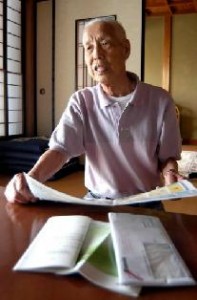Nuclear Reactors Rekindled, Part 1, Article 3
Jul. 1, 2012
Part 1: Through the eyes of A-bomb survivors
Article 3: Torn emotions of A-bomb survivors
by Michiko Tanaka, Staff Writer
Concern over electricity supply clashes with safety fears
In an invitation letter for a meeting of shareholders, sent by the Chugoku Electric Power Company, a bulletin was enclosed. The company, located in downtown Hiroshima, was set to hold the meeting in late June. The bulletin offered information about “safety measures for the Shimane nuclear power plant.” It explained countermeasures designed to defend the power station in the event of a tsunami, such as installing an emergency power supply at a higher elevation and reinforcing breakwater walls.
“No matter what they say, I can’t trust it,” said Tadao Ashishiba forcefully. Mr. Ashishiba, 86, is a resident of Yonago City in Tottori Prefecture and the chairman of the Tottori Prefectural Confederation of A-bomb Survivors Organizations.
Mr. Ashishiba worked for the Chugoku Electric Power Company, mainly as an engineer involving hydro power, until the age of 60. He worked for the company his whole life, joining the forerunner of the firm, the Chugoku Electric Power Distribution Company, when he was just 17 years old. On August 9, 1945, three days after the atomic bombing of Hiroshima, he was dispatched to the city from Yonago to engage in restoration work for about 10 days. “I was horrified to the core, wondering whether people would ever be able to live there again,” Mr. Ashishiba recalled. With these thoughts, he went on with his work, helping to raise utility poles in the devastated city.
The No. 1 reactor at the Shimane nuclear power plant, located in the city of Matsue in Shimane Prefecture, began commercial operations in March of 1974. It was the first nuclear reactor in Japan to be built domestically. As an employee of the company, he took pride, above all, in the words “peaceful use of nuclear energy.” He believed that an enormous amount of energy could be produced at a low cost and the local community in the plant’s vicinity would benefit from the subsidies offered by the government. Mr. Ashishiba even went so far as to give tours of the plant for some of the residents from his own town.
But his pride was dashed on March 11, 2011 when disaster struck at the Fukushima No. 1 (Daiichi) nuclear power plant. After the accident, Mr. Ashishiba expressed remorse before the executives of the Tottori Prefectural Confederation, saying, “The safety of nuclear energy had been hammered into my head by the company, but it’s a myth--there is no absolute safety when it comes to atomic power.”
Mr. Ashishiba’s view has changed, and he now feels that an end to Japan’s reliance on nuclear energy must be realized in the future. But he added, “For the moment, at least, we have no choice but to continue operating the nuclear plants, with safety as the top priority.” Emotionally, Mr. Ashishiba feels even more torn since the Oi power station, located in Fukui Prefecture, was restarted by the Kansai Electric Power Company.
Public opinion on the question of eliminating nuclear energy from the nation is split as well. The first hearing of citizens’ views on the ratio of nuclear energy to Japan’s total energy consumption in the future was organized by the government for July 14. The series of hearings will be held in various locations across the country. With the percentage of nuclear energy usage standing at 26% in 2010, three options for the future--by the year 2030--are being considered at the hearings: 0 percent, 15 percent, or 20-25 percent.
“Electricity is the backbone of Japanese industry. As Japan is a nation not blessed with natural resources, it must rely on nuclear energy,” said Tetsuro Mukai, 91, a resident of Higashi Ward, Hiroshima. Like Ashishiba, Mr. Mukai worked for the Chugoku Electric Power Company as an engineer.
Mr. Mukai was exposed to the atomic bombing while at the headquarters of the Chugoku Electric Power Distribution Company, located 680 meters from the hypocenter. He was sitting at his desk, making a phone call to a branch office, when he and the desk were blown into the air by the A-bomb blast. “I barely survived,” Mr. Mukai said. Later, he experienced such acute symptoms of radiation sickness as hair loss and fatigue.
Still, Mr. Mukai stressed, “Lumping together the atomic bomb and nuclear power plants in discussing the energy issue isn’t right. For the moment, the only thing we can do is fully implement safety measures in order to prevent any further accidents.”
Both engineers, who suffered the atomic bombing and carried out the work of establishing a stable supply of electricity for Japan, posed the same question: “Can the nation really change its current way of life?”
The Japanese government plans to articulate its new energy policy as early as August.
(Originally published on July 18, 2012)








